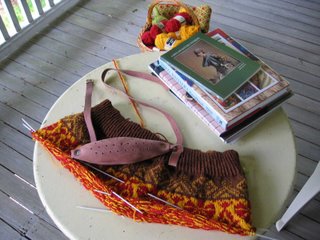
I had read of the legendary Shetland knitters who could knit 200 stitches per minute in the days before circular needles were invented, using long double pointed needles and a belt. I was hoping that I, like them, would be able to finish a fair isle sweater every week, and that I would be able to indulge my passion for yarn and try all the patterns I desired, make all the Alice Starmore sweaters I coveted, and experiment with the colors of the rainbow, all to my hearts content.
Doesn’t it sound like a dream?
I experimented for a while, and although I loved some things about the belt, I was not able to get proficient at the technique, and threw the belt and needles into a dark corner in disgust. They have remained in my box of knitting paraphernelia until I recently thought I would attempt this again.
My reason for wanting to make another attempt was that I felt my knitting was slower and my stitches less regular than they used to be. Also, I have some problems with my hands and wrists. And elbows and shoulder… And I still have the dream of being able to knit faster so that I can finish more of the garments I want. I can’t help it if I love Norwegian sweaters, Fair Isle sweaters, Aran sweaters, ganseys, elegant sweaters, modern sweaters, Andean bags, lace scarves and shawls and gloves… A coworker once said to me that she used to knit but stopped because she got such a glut of sweaters. Well, to me, that just sounded like crazy-talk.

Above is a picture of the belt and the long needles. As you can see, the belt has a pouch, which is stuffed with horsehair, and has many holes which are used for holding the needle. Since there are so many holes, you can customize your belt to hold different size needles. In Norway they had a "knitting stick" which served the same purpose.
The technique seems simple, you attach the belt around your waist, and you stick your working needle into the belt to keep it supported. This way, your hands do not have to support the garment, and your right hand is free to guide the work without also holding up the weight of the knitted fabric. With stranded knitting, this fabric can be very heavy.
The needles I was able to get were 40 cm (16 in) long, and came in sets of four. The three needles created a very rigid triangle, with the fourth as the working needle. For a large circular sweater, I found it impossible to maneuver my working needle with this configuration. How could you hold it in your lap so you could see your stitches when the triangle wanted to lie in one direction only?

After my difficulties using a four needle set, I added a fifth needle from a different size set. This made a huge difference for me, as the configuration was now more flexible and made it easier to manipulate the work. I will have to order another set of four, because the seller was not willing to break up their sets.

An awkward pose to show the belt without hiding it with my elbows.
Since the needles are so long, I ended up with the pouch of the belt hanging very low on my hips so I could keep my hands closer to my body.
Pros:
1. Because the weight is no longer supported by the hands and wrists, you will feel much less fatigue. It felt WONDERFUL to have the right needle supported this way.
2. Your left hand guides the fabric onto the needle, your right hand is completely free. With a circular needle, you guide the right needle into the fabric and move it up, behind, around…
3. Gravity is helping you somewhat, because the left hand moves the stitch onto the needle, and then you just drop the left needle slightly to make the stitch.
All this adds up to knitting faster and with less fatigue.
Cons:
1. The work is not as portable as a circular needle. Lots of long, lethal needles poking in every direction.
2. A lot of practice is required to become proficient. As a matter of fact, when I called the seller (they had a technical support line) they said that they could offer me no guidance on the use of the belt, and that this belt was only for knitters who had grown up using this method.
3. You have to sit very upright to use this. No lounging and collapsing into a soft couch, because you don’t want the work to tilt upwards, it needs to tilt down away from your body. In all the pictures I have seen, the person was either standing, or sitting very straight. I was only successful if I perched on a pillow or on a dining chair.
All this adds up to less convenience.
Some knitters who use straight needles brace their right hand needle under their arm, and this works on the same concept. You can use the knitting belt with straight needles, you would just enlarge one of the holes in the leather to accommodate the cap of the needle you want to use.
According to Sheila McGregor, in her book “The Complete Book of Traditional Fair Isle Knitting” (B.T. Batsford Ltd, London, 1988), the Fair Isle knitters achieved their speed using the continental style, not the English style of knitting. This is good news, because I suck at the English style. Also, they used sets of four needles, 35 cm long (14 in). This is trickier, because I don’t even know that 14 in needles are available anymore. In my experiments, I determined that for me, more, and slightly shorter, needles would be easier.
I absolutely loved the way it felt to have the right needle supported by a belt. It was a complete delight. My hands and wrists felt infinitely better. Curiously, my knitted fabric was more flat, as if it had been pressed, even though the gauge was the same. I credit this to the fabric being under tension on the straight needle, instead of collapsed on a circular wire. I am still not any faster.
I know I need a lot of practice with this, so I am going to have to practice the knitting belt technique on some smaller project. I will definitely use it with any non-circular project. I am not willing to experiment on my current sweaters. They are too important to me and I want to get them finished without trauma. But this is definitely something that I want to pursue further, and if you have a lot of patience, or any kind of hand and wrist problems, I would really recommend learning the knitting belt technique.

Edited March 1st, 2010: I bought my knitting belt at Schoolhouse Press. You can also get them from Jamieson & Smith.
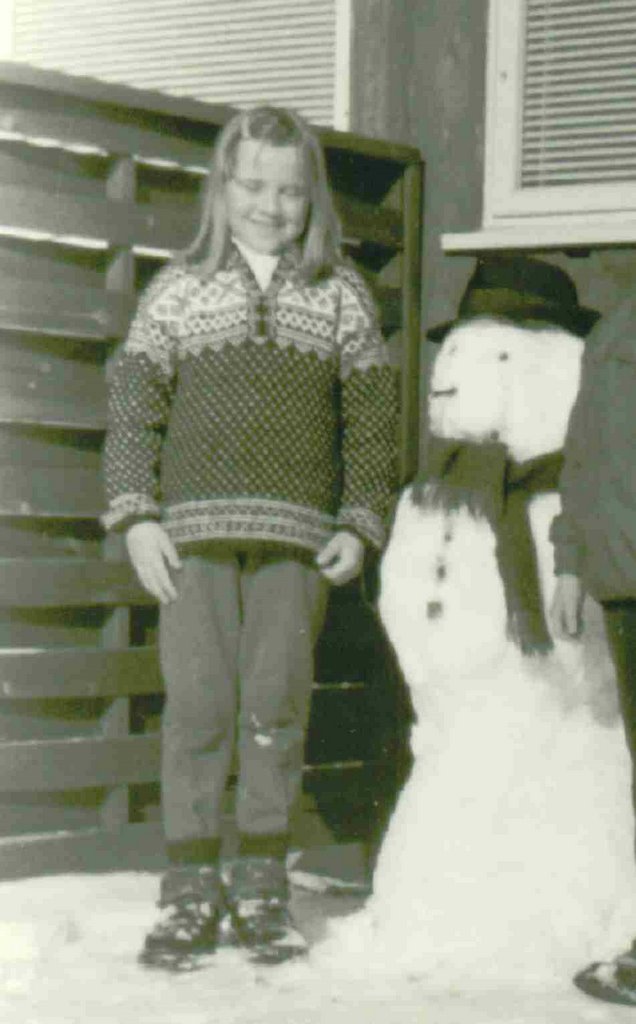


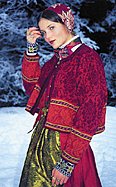


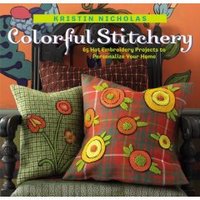


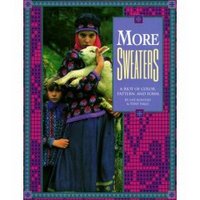






Very interesting info on the knitting belt. I went to Schoolhouse Press but didn't find it and forgot to google. I have never heard anyone mention this before. It's really good to know.
ReplyDeleteI don't have wrist problem yet but I always wonder if circular needle cord would affect the fabric's tension.
Thanks for the post.
Wish you a great weekend. :)
very cool read about the belt. i've never seen one before (as you know norway is all about circs) so thanks for the show and tell!
ReplyDeletecool little contraption... i love the photo showing you using the needles... seem like until you get used to it anyway, it would definitely be kind of awkward
ReplyDeleteOH and am loving the red and yellow sweater that is sitting on your table.
that is so interesting. i don't think i've seen this belt anywhere, either! you must have lots of cool knitting gadgets!!
ReplyDeletei want to see you finish this sweater soon, it looks soo pretty!
Round these parts, we call this "Super Hard Core!"
ReplyDeleteI will stick to my Knit Knack Sack and pule in your direction.
I'm liking your sites.
Thank you for sharing all that wonderful information on the knitting belt! I never knew such a contraption existed. Very interesting to learn about. :) I'm loving your beautiful sweater, by the way. I'm look forward to watching your progress!
ReplyDeleteThat sounds awesome! I really appreciate your spirit of exploration and your willingness to share it with us. Thanks! I think I heard somewhere that you could get those really long needles in France - but I can't remember where I heard that so maybe not so helpful.
ReplyDeleteHi Hege! I was just re-reading this entry of yours about the knitting belt. Did you ever have more success with it? I'm trying to imagine what it is like, and the one thing that trips me up is the bit that holds the needle. Do you have to remove that needle once you've worked it, let it drop, and then stick another one in? That seems a little awkward, so I think I am visualizing it wrong.
ReplyDeleteI've been thinking about getting one of these, but I'm not sure if I could ever get the hang of it. Sitting perfectly straight is a deterrent too, although my grandmother would approve. :)
Ohhh, can you remember where you bought the knitting belt, and the long dpn's?? I really wanna learn to use knitting belt, and those long dpn's. That is how I found your blog!!:-) Regards
ReplyDeleteHelle Reed, Denmark.
Reed@privat.dk
The device that you are talking about is called a "makin". I used to knit with a woman from Scotland who was appalled at how I was "stabbing" myself in the stomach as I used my double points. I always use it when I use double points. It is available on line from Scotland, about $40.
ReplyDeleteI am looking to find a device that knitters used to use that had a larger depression and was worn about the waist. Failing in that search, I may try your suggestion to enlarge one of the holes. thank you for the idea. Mary in Texas
You can find double ended needles from Ardith keef, Gorham, Main.
ReplyDelete1-866-834-1198
you can find the knitting belt on the internet. google "Knitting belt"
Great description of how to use the belt. I bought one in Scotland and no one seemed to know how to use it or where to find the info . thanks.
Thanks for that post. I recently bought a knitting stick AND a belt I figure one of them would work for me.
ReplyDeleteYou didn't have to shoot a video, did you? :-)
Take care.
I enjoyed your site too. I have a friend with a stroke that knits with one hand. Where do I buy a knitting belt or Makin.
ReplyDeleteBetty
Pennsylvania
I bought my "Makin" or knitting belt from a place in Scotland on the internet. I suggest that you google Makin,,,knitting belt or some such. It is leather and nicely done.
ReplyDeleteI bought my knitting belt at Schoolhouse Press. You can also get them from Jamieson & Smith.
ReplyDeleteMy husband bought my knitting belt from Journeyman Leather on the internet direct from Shetland. Its the best bit of kit I've ever had. I'm left handed and always rested my dpns in the crook of my right thigh resulting in a myriad of holes in all my jeans not to mention sore legs. Now I have the belt not only is it more comfortable on my wrists and shoulders I can also knit more quickly and evenly! Yay!
ReplyDeleteknitting is really wonderful, i love to spend my time snitting gloves, dress, or wherever i can do. I really love it because i feel relax when i am doing this activity.That is why i liked this blog very much. I think i reached what i was looking for.
ReplyDelete__________________________________________
related with your sexual life,buy viagra and you´ll find what you are looking for too.I suggest you.
I have bought a knitting belt, and I saw your mention that you have to sit bolt upright but I found that if you move the needle around to a different hole you can sit anywhere. I was able to use it while sitting in my lounge chair with just repositioning the needle. Mind you I am just learning to knit with the belt. Great info love it and send ppl here all the time to read it when they ask about the knitting belt.
ReplyDeleteHello
ReplyDeleteCan I add to this blog and say that I use a knitting belt for all my sock knitting and have for several years now. However, I don't have it round my waist but instead use it 'crossover' style, so that it's level with where I usually hold my dons. I can't knit comfortably without it now and would highly recommend it for easy sock knitting. I live in Scotland and really admire the Sherland way of knitting, although I'm no expert.
Hi from New Zealand
ReplyDeleteI inherited my Shetland Grandmother's knitting belt and I am currently looking for the double pointed needles to use with it.
Granny was so insistent on us learning to kniot the Shetland way and would sit with us correcting the hold muttering, "Och bairns, bairns, bairns" if we slipped up.
Mum was insistent on teaching us about no more than 2 colours in the one row of fair isle and that was because of the way the wool was held over the fingers to avoid dropping it for each stitch. Only two hands, so only two colours. She also taught us about "Rooing" (unsure of the spelling) the sheep instead of shearing them and her wee stock of wool from the heritage Shetland sheep were her treasures, loaned out for school projects.
Could a person who has the use of only her left hand learn to knit with the knitting belt? She has motion and some use of her right arm down to the elbow, but complete paralysis below that. She is very proficient with her left hand. I really think if she has the patience to learn this, and if it's possible, that it would greatly enrich her life.
ReplyDelete